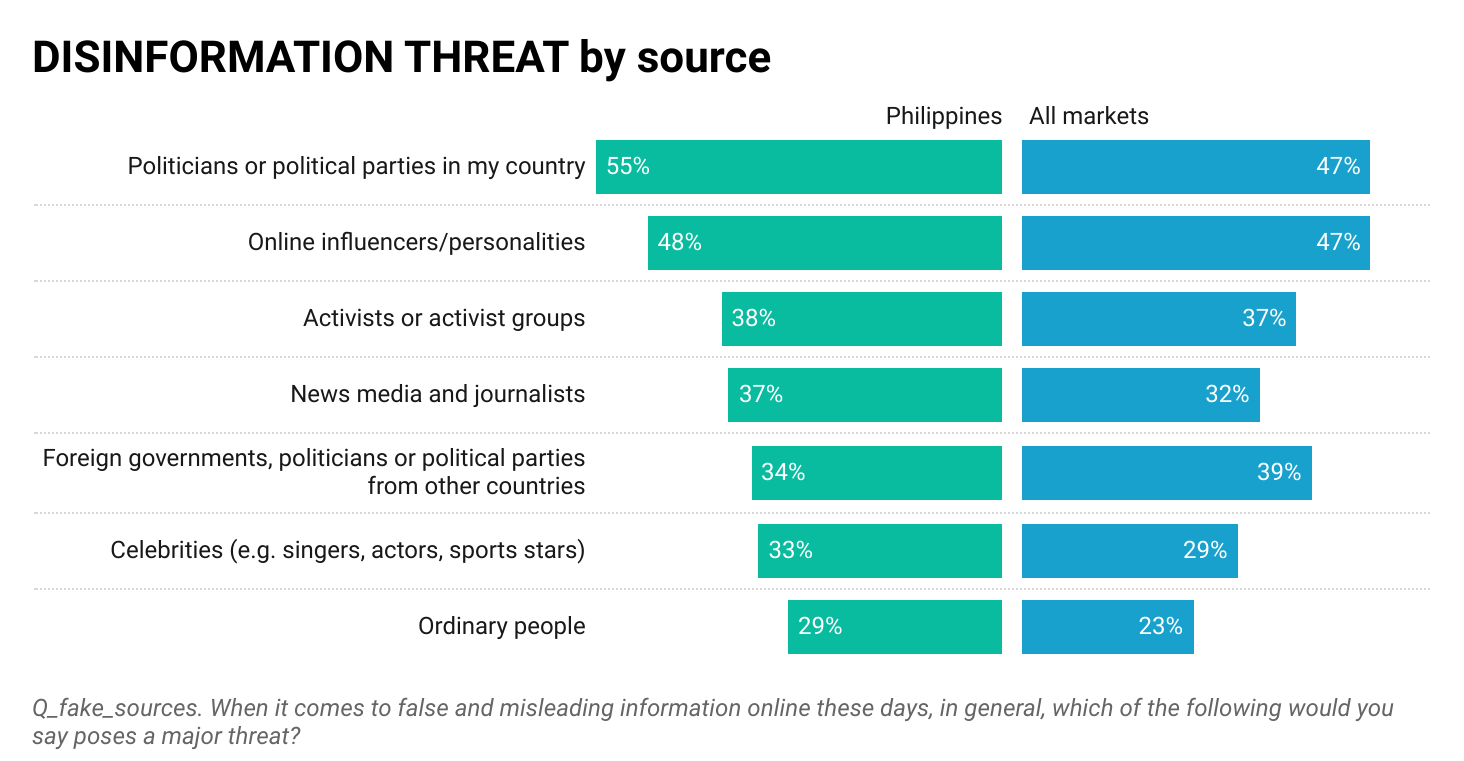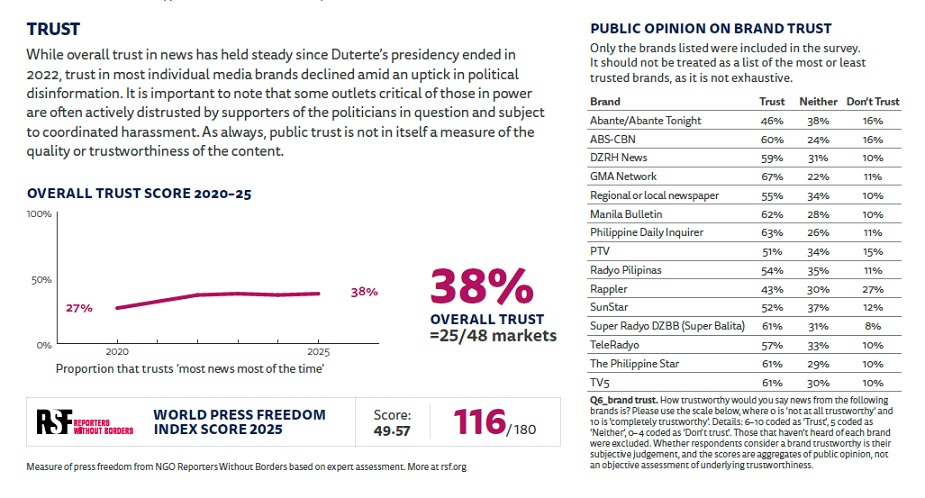Concern over online mis- and disinformation in the Philippines climbed to a record 67% in early 2025 amid a politically charged midterm election season that saw Vice President Sara Duterte impeached on corruption charges and former president Rodrigo Duterte arrested by the International Criminal Court for crimes against humanity tied to his brutal drug war.
This was the highest level recorded since the country was included in the Reuters Institute Digital News Report (DNR) in 2020. The latest edition, which polled 97,055 respondents across 48 markets in six continents online from mid-January to late February, including 2,014 adult Filipinos, was released on June 17.
This year’s report also highlights how Filipinos have been increasingly turning to podcasts and AI chatbots for news while remaining cautious about fully automated journalism. It also documents rising verification habits, shifting platform preferences, and evolving trust dynamics.
Who spreads disinformation?
The four-point rise in concern about mis- and disinformation from 2024 (63%) and 10-point leap from 2020 (57%) place the Philippines nine points above this year’s global average of 58% and seven points above the average for the Asia Pacific region (60%). The steady climb in these concerns over six years underscores a growing sense of public anxiety about the spread of false or misleading content online
Concern was notably higher among Filipino women (70%), those aged 55 and above (76%) followed by 18- to 24-year-olds (70%), as well as among those with higher income (78%), higher education (74%), and those residing in the Visayas (73%).
Unlike the global sample, which identified both politicians and online influencers as playing the biggest role (47% each) in the spread of false or misleading information, Filipinos viewed political actors (55%) as a greater threat than online influencers (48%), activists (38%), journalists (37%), foreign governments (34%), celebrities (33%), and ordinary people (29%). Concern about journalists as a source of false information was five points higher than the global average of 32%.
Filipinos most commonly encountered disinformation on social media, more than on messaging apps, search engines, or through face-to-face conversations. Facebook topped the list at 68%, well above the global average of 49%, followed by TikTok (48%), YouTube (39%), X (27%), and news websites (22%). Across all markets, however, X and Instagram were perceived as bigger disinformation threats than YouTube, a contrast to the Philippine experience.
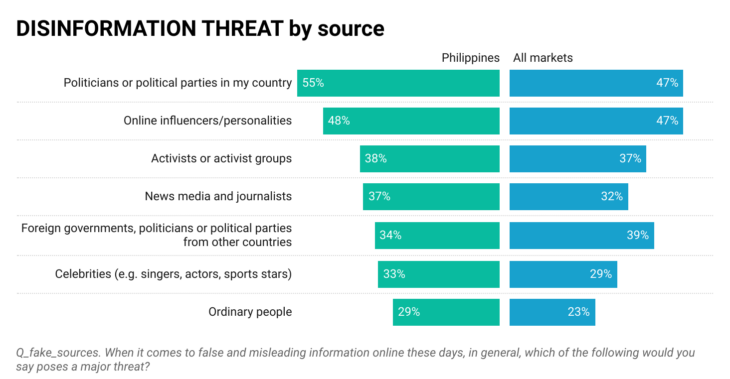
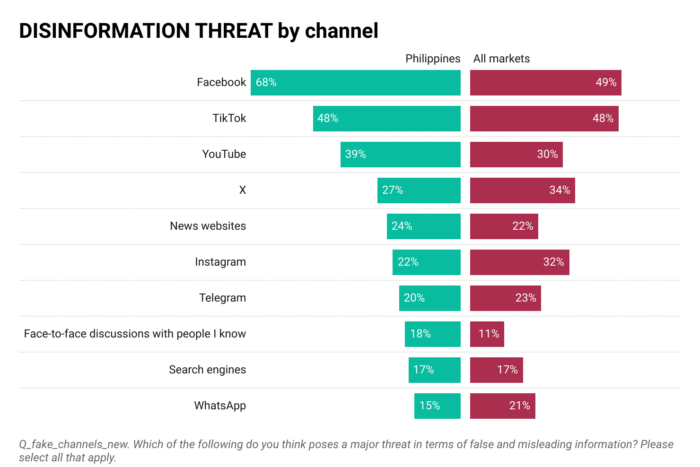
Concerns about content moderation on social media and video-sharing platforms also persisted. While a third of Filipinos considered current moderation levels sufficient, more than one in four (27%) believed platforms did too little to remove misleading or harmful content, reflecting a public preference for stronger accountability from digital platforms.
How Filipinos verify
As they grappled with online mis- and disinformation, Filipinos turned to a range of sources to verify suspicious information. Unlike the global sample, where trusted news outlets were the top choice, 40% of Filipinos said they relied on official government websites or agency channels, slightly ahead of trusted news brands (37%).
A striking 34% consulted fact-checking sites, nine points higher than the global average of 25%. This suggests greater awareness of the role and value of fact-checkers in combating false or misleading content.
However, among the 27% of Filipino respondents who turned to social media to validate information, 45% looked for posts from official or government sources, 35% from influencers, 34% from journalists, and 26% from fact-checkers and subject experts. This suggests that while trusted sources matter, public figures and content creators play a significant role in shaping the narrative on social media.
In the Philippines, AI chatbots have also emerged not only as news sources (9%) but as tools for verifying information (10%), especially among those under 35. As in other markets, ChatGPT was the most widely used chatbot, followed by Meta AI and Google Gemini.
More than a third of adult Filipinos (36%) told the survey they had received education or training on how to use news, far above the global average of 22% and even higher than Finland (34%), one of the countries with the highest levels of news literacy training. Nearly half (47%) of Filipinos under 35 reported having received such training.
Multiple sourcing was also common among younger Filipinos. The proportion of those who used three sources to verify information was highest among 18- to 24-year-olds (26%), who also ranked second (12%) in using four sources for verification.
Warming to AI, with caution
Despite the growing use of AI chatbots to access and verify news, Filipinos generally remained cautious about fully automated journalism. Only 21% said they were comfortable with news generated mostly by artificial intelligence with some human oversight, while a larger share (35%) preferred news written by humans but assisted by AI.
However, AI-powered personalization was more welcomed: 31% liked AI-summarized news, 29% favored story recommendations based on personal interests, 27% appreciated simplified or translated articles, and 25% said they would use a chatbot to answer questions about the news.
Respondents across countries expected AI to make news cheaper and more timely, but also worried it would make journalism less transparent, accurate, and trustworthy, according to the DNR.
Where Filipinos get news
Like AI chatbots, news podcasts have gained traction in the Philippines. One in eight adults (12%) cited them as a source of news in the past year, roughly matching the share who relied on print (13%) but still trailing those who turned to radio (17%). Podcast consumption was highest among Filipinos aged 25 to 34 (15%).
When asked which podcasts they listened to, Filipinos mostly named leading traditional TV networks and their associated news programs.
Traditional media have lagged behind online sources (85%), including social media (66%), as the primary source of news for Filipinos since the Philippines first appeared in the Digital News Report in 2020. However, traditional media usage held steady this year, likely reflecting a renewed demand for credible information amid rising political tensions in an already volatile election year.
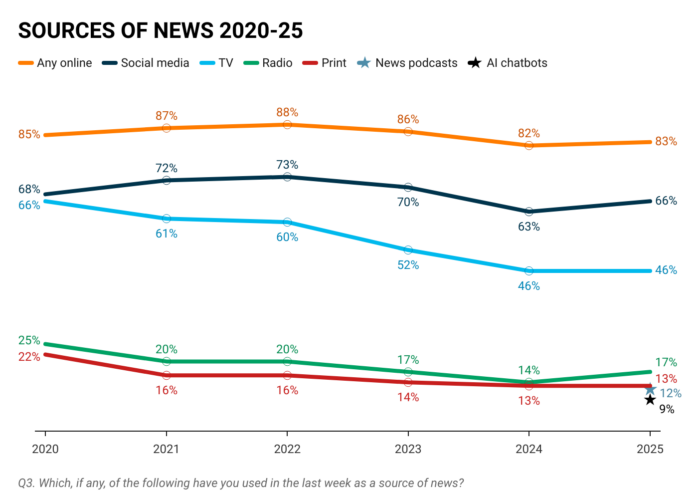
It is worth noting, however, that only a fourth of Filipinos said they went directly to a news website or app to get news online, opting instead for social media (61%) and search engines (52%) as their main gateways.
Facebook (65%) and YouTube (50%) remained the top platforms for news among Filipinos, followed by TikTok (29%), which overtook Facebook Messenger (27%) to become the third most-used source.

Watching over reading
Filipinos’ preference for watching news (51%) over reading (29%) or listening (13%) helps explain the strong performance of video-driven platforms like YouTube and TikTok. According to the DNR, this viewing preference is also encouraging a shift toward individual news creators.
The Philippines’ watch rate is significantly higher than the global average of 31%, placing the country among the top markets where platforms like YouTube and TikTok were used for news in the past week.
In terms of actual use, 58% of Filipinos watched news-related videos on Facebook, followed by 49% on YouTube, 30% on TikTok, and 29% on a news website or app.
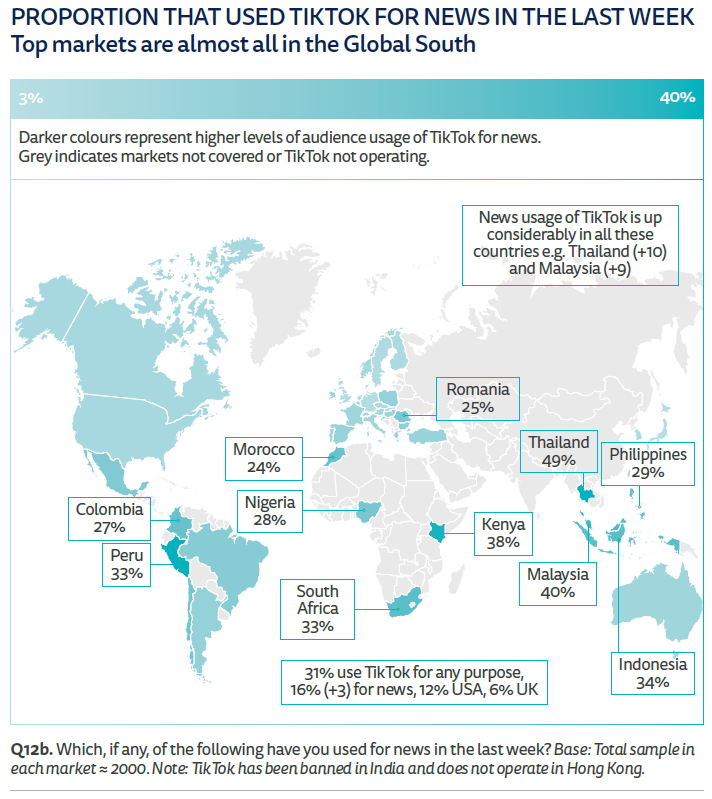
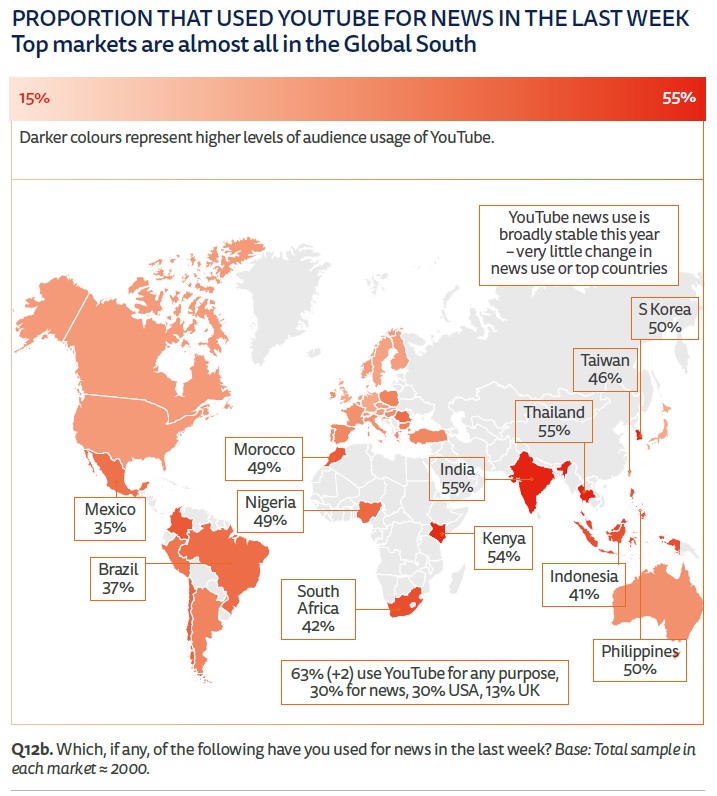
Favoring journalists
Filipinos on social media were more likely than users globally to pay attention to news outlets and journalists rather than personalities, according to this year’s DNR. On Facebook, 66% of Filipinos said they focused on journalists, surpassing the global average of 44%, while only 35% followed personalities (vs. 25% globally).
The trend was most pronounced on X, where 73% of Filipinos prioritized journalists over personalities (52%). On YouTube, 70% cited news outlets as their main source, markedly greater than the global average of 43%.
Even on TikTok, Filipinos leaned toward authoritative sources (61%) more than personalities (54%), reversing the global trend.
Instagram was the exception: more Filipinos followed personalities (66%) than journalists (59%).
Regaining trust
Like the rest of the markets, overall trust in the news among Filipinos held steady (38%), nearly identical to the global average (40%). However, trust in most individual media brands included in the survey declined. Public trust is not in itself a measure of the quality or trustworthiness of the content.
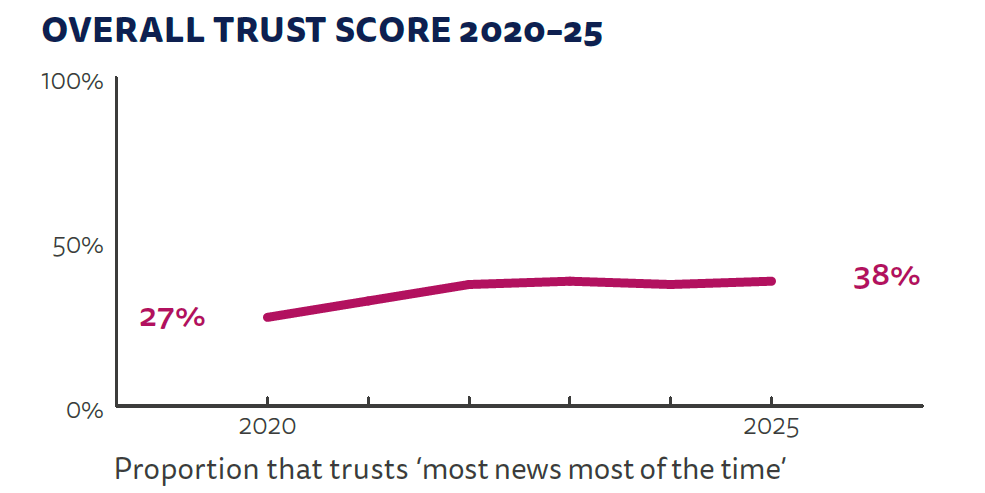
News avoidance also remained high at 48%, placing the Philippines among the top 10 globally. A significant share (41%) cited excessive political coverage, while 38% said the news negatively affected their mood. One in three (34%) pointed to untrustworthy or biased reporting, and one in four (28%) to too much coverage of wars and conflicts.
Signs of news fatigue were also evident: 27% said they felt worn out by the sheer volume of news, a sentiment echoed by 31% of respondents globally.
While only 13% said they found the news hard to follow or understand, it suggests there is still room to make news more accessible and relatable.
Filipino audiences offered suggestions for how the media can regain their trust, cutting across four key themes: accuracy and truth-telling, transparency, impartiality, and better reporting.
In terms of accuracy, many emphasized the need to stick to verifiable facts, multiple sourcing, and fact-checking.
Others urged disclosure of sources and evidence, including transcripts, videos, images and data in the spirit of transparency.
Calls for impartiality echoed throughout the responses, especially the need for balanced news and independence from sources, especially politicians.
Many also demanded timely and original reporting and urged journalists to be present on the ground instead of relying mainly on algorithm-driven trends.
(Yvonne T. Chua is an associate professor of journalism at the University of the Philippines. She has been writing the profile on the Philippines for the Digital News Report since 2020.)
